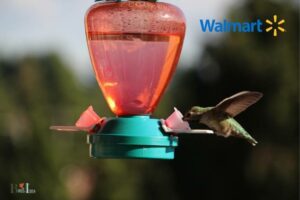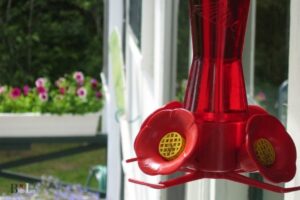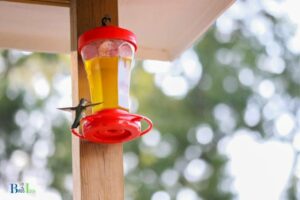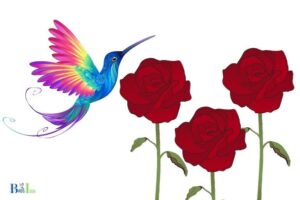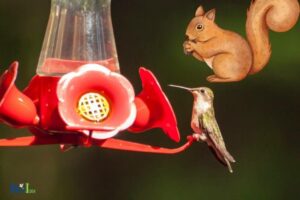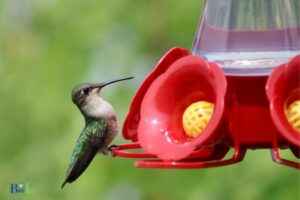How Long to Leave Hummingbird Feeders Out: Mar-Oct!
Hummingbird feeders should be left out from early spring to late fall, approximately between March and October.
Hummingbirds are migratory birds, and the ideal time to put out feeders for them depends on their migratory patterns. In most regions, hummingbirds arrive during early spring and stay until late fall.
By placing a feeder out during these months, you can help provide a consistent food source for these tiny birds as they visit your area.
It’s essential to maintain the hummingbird feeders throughout the season by cleaning them every few days and refilling with fresh nectar. This helps prevent mold growth and keeps the birds healthy.
Additionally, monitor the weather conditions, as feeders may be needed longer into the fall if cold snaps are delayed, or removed earlier if the cold arrives prematurely, to ensure the hummingbirds continue their migration journey safely.
7 Regions: How Long to Leave Hummingbird Feeders Out
| Region | When to Put Up Feeders | When to Take Down Feeders | Notes |
| Northeast | Early April | Late October | Closely monitor temperatures and migration |
| Southeast | Mid-March | Late October | Some areas may support year-round hummingbirds |
| Midwest | Early April | Late October | Closely monitor temperatures and migration |
| Southwest | Mid-March | Late October | Some areas may support year-round hummingbirds |
| Northwest | Early April | Late October | Closely monitor temperatures and migration |
| West Coast | Mid-February | Late October | Some areas may support year-round hummingbirds |
| Mountain West | Late April | Early October | Closely monitor temperatures and migration |
Key Takeaway
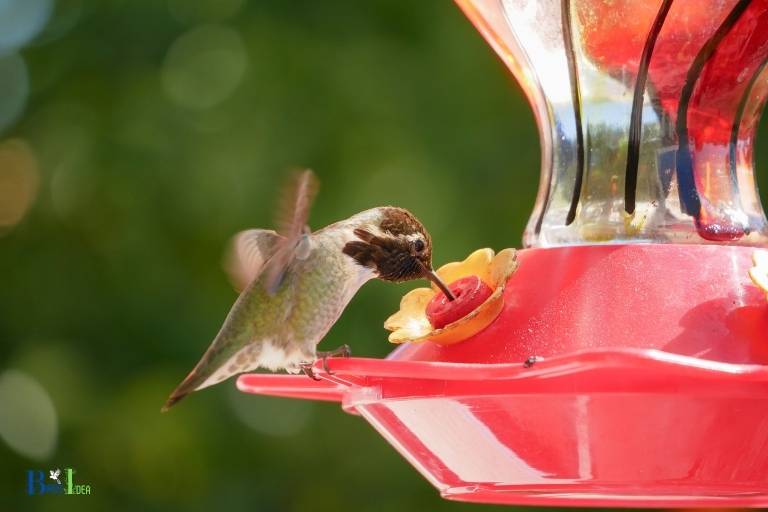
Five Facts About: To Leave Hummingbird Feeders Out
Understanding The Optimal Time Duration For Hummingbird Feeders
Hummingbirds are fascinating creatures that have captured the hearts of bird enthusiasts and wildlife lovers alike. One way to attract these lovely birds to your garden is by setting up a hummingbird feeder.
However, it’s important to know the optimal time duration for leaving out hummingbird feeders, especially during different seasons.
We’ll explore the factors that govern how long to leave a hummingbird feeder out.
The Importance Of Timing For Hummingbird Feeders
Hummingbirds’ diet primarily consists of nectar that they get from flowers and feeders. Nectar provides the fuel that hummingbirds need to survive, especially during migration season.
Leaving a feeder out of season may not be beneficial for the hummingbird and could even go as far as causing harm.
It is essential to know when to leave the feeder out so that you can not only help the hummingbirds but also enjoy their presence.
Factors That Influence Hummingbird Feeder Duration
Several factors can influence the optimal duration for hummingbird feeder usage.
Here are some of the most important:
- Seasons: Predominantly, hummingbirds migrate south during the wintertime, so it won’t be necessary to keep the hummingbird feeders out for an extended period. But different regions experience different weather patterns, and the optimal time duration may vary. In regions where it does not snow, leave the feeder out all year round.
- Feeder placement: Hang your feeder in a spot that is not exposed to direct sunlight and receives adequate shade. If your feeder is in direct sunlight, the sugar water will quickly ferment, and mold may develop, leading to infections and diseases.
- Quantity of food: The number of birds attracted to the feeder directly influences the length of time that you need to leave it out. If several birds are feeding on the sugar water, refill the feeder frequently, and leave it out for longer periods.
- Humidity: Atmospheric humidity plays a part in how quickly the sugar water ferments. If it’s humid, the sugar water won’t last long, and you’ll need to refill the feeder more often, which in turn means that you need to leave it up for shorter periods.
- Cleanliness: Keep your feeder clean and maintained. Insects, dirt, debris, and bird waste could grow on the feeder that might harm the birds’ health, and mold and insects’ growth become quicker. The faster mold forms, the sooner you’ll need to take the feeder in. It’s recommended to clean the feeder before refilling it each time.
- Availability of natural food: The presence of naturally available food influences how often hummingbirds visit feeders. During the nest-building and breeding seasons, hummingbirds primarily rely on insects to feed their young. The natural food sources will encourage hummingbirds to come to your yard for an extended period, so you may only need to leave the feeders up for a short time.
How long to leave hummingbird feeders out depends on several factors such as the number of birds attracted, the feeder’s placement, the season, humidity, cleanliness, natural food availability, and more.
By considering these factors, you can ensure that your hummingbird feeders remain fresh and healthy for your feathered friends.
How Long Should You Leave Hummingbird Feeders Out In Different Seasons?
Spring/Summer: Ideal Duration For Hummingbird Feeders
Spring and summer are the prime seasons for hummingbirds, and as such, it’s essential to have a well-maintained feeder out for them to enjoy.
Here are some key points to consider regarding the ideal duration for hummingbird feeders in these seasons:
- Leave your hummingbird feeder out from early spring until late summer.
- Continue to fill and clean your feeder throughout this time, as hummingbirds will rely on it as a consistent food source.
- Consider staggering the hanging of multiple feeders to disperse territorial behavior among hummingbirds and reduce competition.
- In hotter weather, change the nectar more frequently as it can spoil more quickly.
- Remember to keep your hummingbird feeders away from direct sunlight to avoid overheating the nectar.
Fall/Winter: How To Adjust Your Feeder For Better Results
As the seasons change, it’s still possible to attract hummingbirds to your yard by being mindful of their behavior and feeding preferences.
Here are some key points to consider regarding how to adjust your feeder for better results in the fall and winter:
- Reduce the number of feeders you have out as hummingbirds begin to migrate to warmer climates during this time.
- Leave a feeder out for any stragglers that may still be passing through, but be mindful not to rely on a full feeder for more than a few days.
- Consider adding a suet feeder to your yard to attract insect-loving birds, which may in turn attract hummingbirds.
- Clean and store your feeders properly during the off-season to ensure they remain in good condition for the following year.
Temperature And Weather Factors To Consider
Beyond seasonal considerations, there are temperature and weather factors to consider when it comes to hummingbird feeders.
Here are some key points to keep in mind:
- If the temperature drops below freezing, the nectar in the feeder can freeze and harm the birds. Remove the feeder temporarily until the temperature warms up.
- In high winds, secure your feeder to prevent it from swinging too much, which could deter hummingbirds from using it.
- Rainwater can dilute the nectar and promote the growth of harmful bacteria. Protect your feeder from rain by placing it in a sheltered area or using an umbrella. Additionally, it’s recommended to replace the nectar if it becomes diluted or contaminated.
- Finally, remember that it’s important to clean your feeder regularly, regardless of the season or weather. Use a solution of one-part vinegar to four-parts water to clean the feeder and wash it thoroughly before each refill.
By being mindful of these factors and adjusting accordingly, you can attract hummingbirds to your yard year-round and provide them with a reliable and safe food source.
How Long Should You Leave A Hummingbird Feeder Out Without Cleaning?
Hummingbirds are fascinating creatures that many people enjoy watching in their backyard. One way to attract them is by using a hummingbird feeder, which contains a sugar-water solution that mimics the flowers they feed on.
However, many people wonder how long they should leave the feeder out without cleaning it.
We will explore the optimal cleaning frequency for hummingbird feeders, the impact of dirty feeders on hummingbirds’ health, and best practices for cleaning them.
Optimal Cleaning Frequency For Hummingbird Feeders
Hummingbird feeders should be cleaned regularly to prevent mold, bacteria, and other contaminants from growing inside them. The optimal cleaning frequency depends on the weather and how often the feeder is used.
Here are some general guidelines to follow:
- In hot weather, clean the feeder every 2-3 days because the sugar-water solution can spoil quickly.
- In moderate temperatures, clean the feeder every 5-7 days.
- In cold weather, when hummingbirds are less active, clean the feeder every 10-14 days.
The Impact Of Dirty Feeders On Hummingbirds’ Health
Dirty hummingbird feeders can have a negative impact on the health of these tiny birds.
Here are a few reasons why:
- Mold and bacteria can grow inside the feeder and contaminate the sugar-water solution, which can make hummingbirds sick.
- Bees, wasps, and other insects can be attracted to the sticky residue left behind by the sugar-water solution, which can scare away hummingbirds and potentially sting them.
- Ants can also be attracted to the feeder, which can contaminate the sugar-water solution and make it less appealing to hummingbirds.
Best Practices For Cleaning
Cleaning your hummingbird feeder regularly is crucial for the health of these delicate birds.
Here are some best practices to follow:
- Use hot water and a bottle brush to scrub the feeder thoroughly, making sure to remove any mold or residue.
- Do not use soap, bleach, or other chemicals to clean the feeder because they can be harmful to hummingbirds.
- Rinse the feeder thoroughly with hot water to make sure all residue has been removed.
- Make a fresh sugar-water solution and refill the feeder.
- When in doubt, clean the feeder more often rather than less often.
Hummingbirds bring joy and beauty to our lives, and we must take care of them by maintaining clean hummingbird feeders.
By following the guidelines we have outlined, you can help ensure that these amazing birds stay healthy and vibrant in your backyard.
How Long Should You Leave Hummingbird Feeders Out In Different Regions?
Hummingbirds are fascinating creatures that provide a mesmerizing sight with their swift and graceful movements. No wonder many people enjoy having hummingbird feeders in their backyards.
One of the most common questions that arise among hummingbird enthusiasts is how long they should leave the feeders out.
The duration can vary depending on the region, and in this post, we will delve into that topic. Let’s get started.
Feeder Duration In The Northern Us States
In the northern us states, hummingbirds mainly migrate to mexico and central america during winter. Therefore, it is essential to take down the feeders before the migration begins to avoid delaying their departure.
Here are some key points about feeder duration in the northern us states:
- Begin reducing the amount of nectar in the feeder from mid-september.
- Take the feeder down by early october to prevent the nectar from freezing.
- Leave the feeder down until late april to avoid confusing early arrivals.
- Clean the feeder regularly throughout the year.
Feeder Duration In The Southern Us States
In the southern us states, hummingbirds do not migrate far away during winter. As such, feeders can be left out longer than in the northern us states.
Here are some crucial points to note about feeder duration in the southern us states:
- Refill the feeders every four to five days to prevent spoilage.
- Clean the feeder once or twice a week.
- Leave the feeder out all year round.
- If the temperature drops below 20°f
Adapting Your Feeder Duration To Local Conditions
Local conditions can also influence the duration you should leave the feeders out.
Here are some additional points to note:
- If the temperature is consistently below freezing, take your feeder down to avoid freezing.
- If ants, bees, or wasps become a problem, take down the feeder for a day or two, clean it thoroughly, and move it to a new location.
- If you notice mold in your feeder, take it down immediately and disinfect it with a 10% bleach solution.
- In hot weather, change the nectar solution every two to three days to prevent spoilage.
Hummingbirds are delightful creatures to observe, and having a feeder can increase your chances of seeing them. However, it is essential to understand the best practices for feeder duration to keep the hummingbirds safe and healthy.
Follow the tips above, and you will enjoy the mesmerizing sight of hummingbirds in your backyard all year round.
FAQ Of How Long To Leave Hummingbird Feeders Out
How Often Should I Change The Nectar In My Hummingbird Feeder?
What Is The Best Time Of Day To Refill Hummingbird Feeders?
Should Hummingbird Feeders Be Taken Down In The Winter?
How Long Should Hummingbird Feeders Be Left Out In The Fall?
Conclusion
As you can see, there is no set answer for how long to leave your hummingbird feeders out. It ultimately depends on your location and the patterns of the hummingbirds in your area.
However, keeping a few things in mind can help you make the most of your feeder.
Remember to clean it regularly, change the nectar every few days, and keep an eye out for signs of spoilage or mold. Additionally, consider investing in a weather-resistant feeder to ensure it lasts longer through different seasons.
Enjoy the sight of these beautiful creatures and share that joy with your family and friends by keeping your feeder out for as long as possible.
You’ll soon find that the effort it takes to maintain your feeder is worth it when you see all the hummingbirds it attracts!

